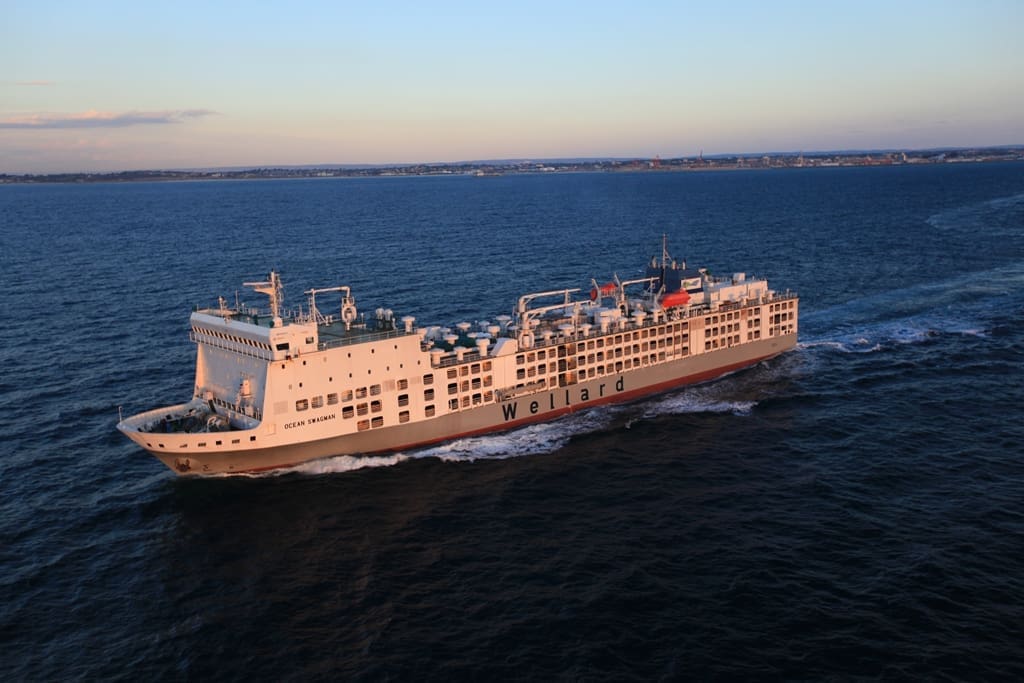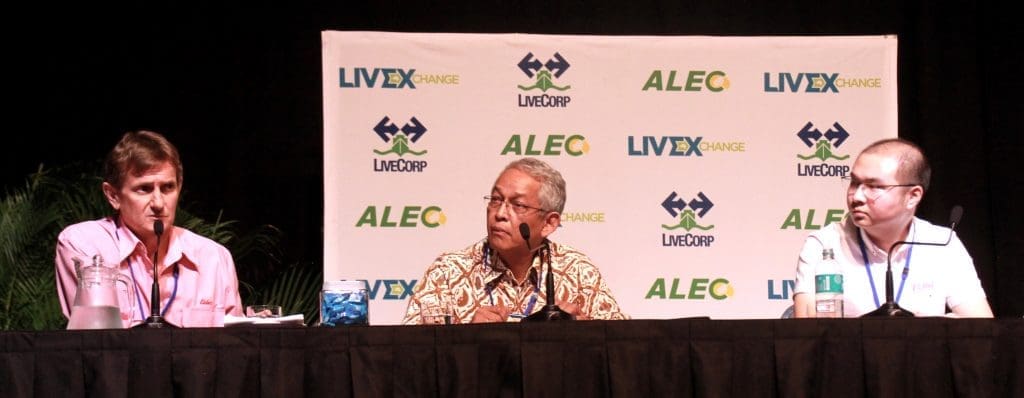 Australia’s northern cattle industry may just fall short of filling Indonesia’s orders for 200,000 cattle this quarter, official port data and trade estimates suggest.
Australia’s northern cattle industry may just fall short of filling Indonesia’s orders for 200,000 cattle this quarter, official port data and trade estimates suggest.
The general consensus among exporters at the Livexchange conference in Darwin last week was that the trade is set to ship around 170,000 to 180,000 cattle to Indonesia by December 31.
Exporters sent 50,000 cattle in October from the Port of Darwin and an estimated 45,000 head in November (official November figures will not be available until next week),
Shipments from Townsville totaled 30,000 head in October and 25,000 in November.
Assuming shipments of around 10,000 head per month from Broome during October and November, the total shipped for the first two months of the three-month quarter was around 170,000 head, which includes some cattle to Vietnam.
While exporters shipped over 60,000 cattle from Darwin in December last year and December 2013, December shipments this year are predicted to be quiet.
The onset of the wet season limits access to cattle at this time of year, and producers also appear to be hanging onto cattle where they can in the hope that prices will rise even further above the current levels of up to $3.50c/kg.
Exporters reported that despite the higher money now around it is still proving difficult to lure the cattle they need out of paddocks.
While producers are hoping for more money, Indonesian importers told the told the conference they are losing around $180/hd at current price levels and said the market will struggle to absorb further rises in the price of cattle.
Annual permit indications
The trade is now waiting for the Indonesian Government to indicate how many cattle it plans to import in 2016, with an announcement on annual permits expected any day.
Whether it will be a flimsy statement of intent or a more formal permit commitment, against which importers, exporters and producers will have the confidence to make commercial decisions, is not yet clear.
Indonesia has already announced it will release permits every four months next year instead of every three months.
This change will add some certainty to the trade and should help to ensure the supply of cattle to Indonesia is better matched to the peak periods of demand, such as Ramadan.

Dick Slaney, Dicky Adiwoso and Wilson Hasan speaking on a panel during the Livexchange 2015 conference in Darwin.
Use $3/kg to invest in supply upgrades
Wilson Hasan from TUM, one of the largest cattle importers and lot feeders in Indonesia, is urging Australian producers to use the higher prices they are now receiving to invest in upgrading infrastructure to improve supply capability.
Indonesia had lost six million farmers between 2003 and 2013 as the country urbanised, creating an increasing gap between supply and demand and “a very big opportunity for Australia”.
“My message to you is, now you are getting $3/kg, I believe you have to rapidly expand infrastructure and fencing,” Mr Hasan told the Livexchange conference.
“We hear that the wet season closes down 50pc access to roads and cattle.
“I believe there is an opportunity to increase that and 50pc utilisation of land in the Northern Territory.
‘We are not very far from 1.5 million head per year’
“You should have the confidence. We’re not very far from I’d say 1.5 million head per year.
“You may not be able to support that but that is the business case.”
Indonesia no longer a “frontier”
Dicky Adiwoso, a respected figure in the Indonesian-Australian cattle trade, said Indonesia could no longer be viewed as a “frontier” market. It was no longer just “sellers and buyers” but a mature market built on long-term relationships and a quarter of a century of cooperation.
Mr Adiwoso was optimistic the year-old Widodo Government will manage red meat policy well as its understanding of the real economics of red meat production grows.
One challenge to overcome were the strong populist and nationalistic motivations for the Widodo Government to pursue self-sufficiency in beef production. The policy was popular among Indonesian voters and its 20 million farmers, and was also partly fuelled by a level of mistrust of Australia – which had not been helped by the 2011 live export ban.
However Mr Adiwoso told Australian producers to “bear with us”, believing the Widodo Government’s policy approach is changing and maturing as its understanding of red meat economics grows.
He said the Indonesian president was recently shown a breeding operation in Sumatra where he was told that 70 breeding cattle had been turned into 1000 cattle within just four years. This type of misleading information was being used by some officials to accommodate a political agenda in favour of self-sufficiency.
Mr Adiwoso said the challenge was to improve understanding of the real economics of red meat production, such as demonstrating that it takes nine months to produce a calf and large volumes of water and land.
However Mr Adiwoso expressed optimism that a “reality check” will come and the Widodo Government will manage red meat policy well when that happens.
Working more closely
One theme that was visited regularly during an Australia-Indonesian market forum surrounded the question of how Australian cattle producers and Indonesian buyers could work more closely together.
Cattleman John Dyer from Hayfield Station said that despite efforts over the years to get closer to Indonesian buyers, the trade still worked by agents coming to view cattle for sale and offering a price and “that was it”.
Elders Indonesia manager Dick Slaney said importers were happy to provide feedback on cattle performance to producers, but said that in reality very few producers requested it, including some of the bigger pastoral companies.
He urged producers to ask for feedback from their exporter and to travel to Indonesia to see their cattle being fed.
Wilson Hasan from TUM said Indonesian feedlots also did not receive feedback from their customers, the butchers who sell beef in wet markets.
He said butchers considered yield to be the number one priority, and he only heard from butchers if an animal had not yielded well.
“If I do get a phone call it means the yield is bad, if I don’t get a phone call it means the yield is good, and that is the only feedback we get.
“But I do realise that and acknowledge the importance of really measuring and then relaying that information back to the producer.
“We are trying to educate the butcher. The focus of the feedlot is production, that is maximum weight gain, but for the butcher, they don’t care if your ADG is one kilo or 1.5, all they ask for is yield.
“We tell them it does you no good if you don’t relay good information onto us, because we might see ADGs of 1.5 kg/day and say that is really good and we will keep buying those cattle, but at the other end they have really thick bones and really heavy hides that make a loss for the butcher.”
TUM has already been proactive in moving to improve feedback throughout the supply chain by bringing a group of 10 butchers to Australia last year to meet directly with Australian producers.
Another suggestion to bring the trade closer together was for the broader industry to lobby to remove restrictions that currently prevent Indonesians from working on Australian cattle stations, as visitors from many other nationalities can.
Business case facing challenges
Dick Slaney told the conference that the business case for importing and feeding cattle in Indonesia was not as solid as it used to be.
The cost of exporting cattle had increased by 4-5 times in the past eight years, he said, and it now cost about five times more to produce a kilogram of beef in Indonesia through importing and feeding cattle than it did to import beef in a box.
“So it doesn’t take a rocket scientist to work out which business is going to endure,” he said. “That is one for us to watch closely”.
Dicky Adiwoso said the business model still favoured importing cattle instead of boxed beef because Indonesian liked to have a fresh carcase.
However the challenge right now was whether the trade could absorb the high purchase price of cattle from Australia.
He said breeding cattle in Indonesia could become a more viable proposition as meat became more expensive in the country.



HAVE YOUR SAY